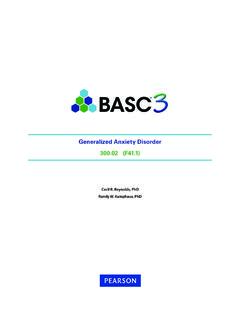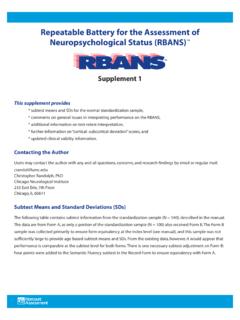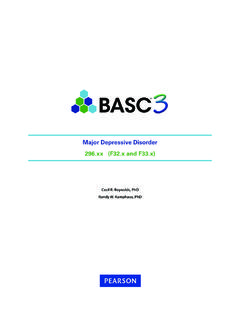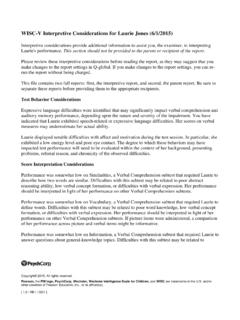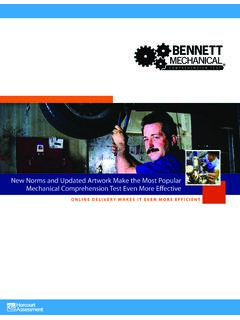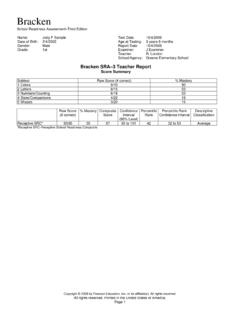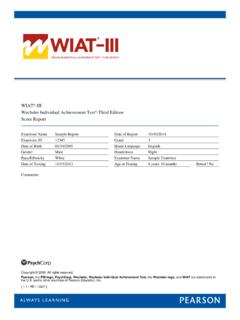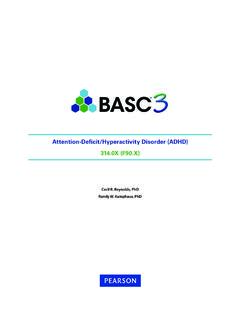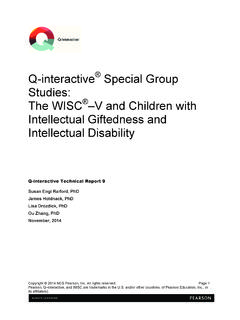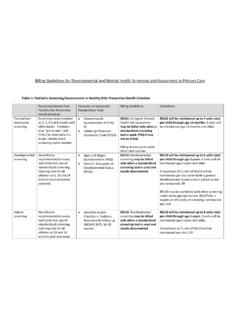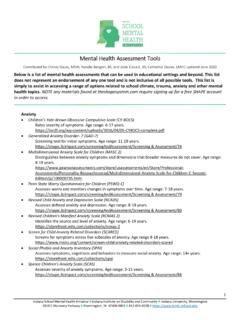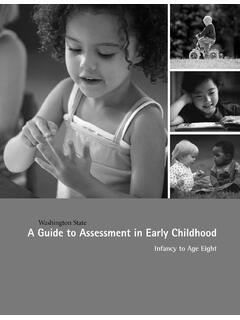Transcription of Manual Supplement for the Clinical Report
1 Behavior Assessment System for Children Second Edition Manual Supplement for the Clinical Report Cecil R. Reynolds, PhD. Randy W. Kamphaus, PhD. Product Number 37764. Pearson Executive Office 5601 Green Valley Drive Bloomington, MN 55437. Copyright 2010 NCS Pearson, Inc. All rights reserved. This Supplement may be printed out by the user of the BASC 2 Clinical Report . Reproduction or transmission in any other form or by any other means, electronic or mechanical, including photocopy, recording, or any information storage and retrieval system, may not be done without permission in writing from the copyright owner. Pearson, the PSI logo, PsychCorp, BASC, and Vineland are trademarks in the and/or other countries of Pearson Education, Inc., or its affiliate(s). DSM IV is a registered trademark of the American Psychiatric Association. Behavior Rating Inventory of Executive Function and BRIEF are registered trademarks of Psychological Assessment Resources.
2 Portions of this work were previously published. Information from the Diagnostic and Statistical Manual of Mental Disorders, Fourth Edition, Text Revision adapted with permission of the American Psychiatric Association, 2010. 1 2 3 4 5 6 7 8 9 10 11 12 A B C D E. For orders and inquiries: Pearson Clinical Assessment, 19500 Bulverde Road, San Antonio, TX 78259. Table of Contents Chapter 1: Features of the BASC 2 Clinical Uses of the BASC 2 Clinical Overview of the BASC 2 Clinical Clinical Probability EBD Probability ADHD Probability Functional Impairment Chapter 2: Development of the Clinical Report Indexes and DSM IV TR Report 13. Development of the Clinical Probability Indexes and the Functional Impairment 13. Development of the Clinical Report 14. Development of the DSM IV TR Report 15. Chapter 3: Standardization, Reliability, and 16. 16. 17. Internal 17. Test Retest .. 21. Interrater ..22. Validity.
3 22. Correlations With Other BASC 2 Correlations With Achenbach System of Empirically Based Assessment (ASEBA) 30. Correlations With Conners' Rating Scales Revised Forms .. 37. Correlations With the Vineland Adaptive Behavior Scales, Second Edition (Vineland II).. 41. Correlations With the Behavior Rating Inventory of Executive Function (BRIEF)..44. Correlations Between BASC 2 Clinical Group 53. References ..56. Appendix: Norms and Interpretive Tables for the Clinical Probability and Functional Impairment Indexes ..57. Table of Contents iii List of Tables Table Clinical Probability Index Items for the TRS-P and PRS-P 4. Table EBD Probability Index Items for the TRS and PRS Child and Adolescent 6. Table ADHD Probability Index Items for the TRS and PRS Child and Adolescent 8. Table Functional Impairment Index Items for the TRS and PRS 10. Table Functional Impairment Index Items for the SRP 12. Table Skewness of Raw-Score Distributions, by Age Level (General Norm Samples).
4 16. Table Coefficient Alpha Reliabilities of Indexes, by Sex and Norm Group, General Norm Table Coefficient Alpha Reliabilities of Indexes, by Sex and Norm Group, Clinical Norm 18. Table T Score Standard Errors of Measurement of Indexes, by Sex and Norm Group, General Norm 19. Table T Score Standard Errors of Measurement of Indexes, by Sex and Norm Group, Clinical Norm Samples .. 20. Table PRS and SRP: Coefficient Alpha Reliabilities of Indexes for the Spanish Forms, by Sex and Test 21. Table Test Retest Reliabilities of Indexes, by Form 21. Table TRS: Interrater Reliabilities of Indexes, by Form Level .. 22. Table PRS: Interrater Reliabilities of Indexes, by Form 22. Table TRS: Intercorrelation of Indexes, Composites, and Scales, General Norm 23. Table TRS: Intercorrelation of Indexes, Composites, and Scales, Clinical Norm 24. Table PRS: Intercorrelation of Indexes, Composites, and Scales, General Norm 25.
5 Table PRS: Intercorrelation of Indexes, Composites, and Scales, Clinical Norm 26. Table SRP: Intercorrelation of Indexes, Composites, and Scales, General Norm 27. Table SRP: Intercorrelation of Indexes, Composites, and Scales, Clinical Norm 28. Table PRS: Intercorrelation of Indexes, Composites, and Scales for the Spanish Forms, General Norm 29. Table SRP: Intercorrelation of Indexes, Composites, and Scales for the Spanish Forms, General Norm 30. Table TRS-P: Correlations With the Achenbach System of Empirically Based Assessment Caregiver- teacher Report Form for Ages 1 Table TRS-C: Correlations With the Achenbach System of Empirically Based Assessment teacher 's Report Form for Ages 6 32. Table TRS-A: Correlations With the Achenbach System of Empirically Based Assessment teacher 's Report Form for Ages 6 33. List of Tables iv Table PRS-P: Correlations With the Achenbach System of Empirically Based Assessment Child Behavior Checklist for Ages 1 34.
6 Table PRS-C: Correlations With the Achenbach System of Empirically Based Assessment Child Behavior Checklist for Ages 6 35. Table PRS-A: Correlations With the Achenbach System of Empirically Based Assessment Child Behavior Checklist for Ages 6 36. Table SRP-A: Correlations With the Achenbach System of Empirically Based Assessment Youth 37. Table TRS-C: Correlations With the Conners' teacher Rating Scale 38. Table TRS-A: Correlations With the Conners' teacher Rating Scale 38. Table PRS-C: Correlations With the Conners' Parent Rating Scale 39. Table PRS-A: Correlations With the Conners' Parent Rating Scale 40. Table SRP-A: Correlations With the Conners Wells' Adolescent Self- Report 40. Table TRS-P: Correlations With the Vineland II teacher Rating 41. Table TRS-C: Correlations With the Vineland II teacher Rating 41. Table TRS-A: Correlations With the Vineland II teacher Rating 42. Table PRS-P: Correlations With the Vineland II Survey Form.
7 42. Table PRS-C: Correlations With the Vineland II Survey Form .. 43. Table PRS-A: Correlations With the Vineland II Survey Form .. 43. Table PRS-C: Correlations With the Behavior Rating Inventory of Executive Function Parent 44. Table PRS-A: Correlations With the Behavior Rating Inventory of Executive Function Parent 45. Table Correlations Between Preschool Forms for TRS and PRS Clinical Indexes and 46. Table Correlations Between Child Forms for TRS and PRS Clinical Indexes and 47. Table Correlations Between Adolescent Forms for TRS and PRS Clinical Indexes and 48. Table Correlations Between Child Forms for TRS and SRP Clinical Indexes and 49. Table Correlations Between Adolescent Forms for TRS and SRP Clinical Indexes and 50. Table Correlations Between Child Forms for PRS and SRP Clinical Indexes and 51. Table Correlations Between Adolescent Forms for PRS and SRP Clinical Indexes and 52. Table Mean T Scores by Clinical 54.
8 Table Clinical Probability Index Mean Score Difference Between the Matched Clinical and Nonclinical Samples for the Item Development and Cross-Validation 55. BASC 2 Manual Supplement for the Clinical Report List of Tables v Chapter Introduction 1. The Behavior Assessment System for Children, Second Edition (BASC 2) teacher Rating Scales (TRS), Parent Rating Scales (PRS), and Self- Report of Personality (SRP) are three of the most widely used tools for assessing behavioral and emotional problems in children and adolescents ages 2 years through 21 years, in both school and Clinical settings. This BASC 2 Manual Supplement describes the purpose, development, interpretation, and technical properties of the newly developed BASC 2 Clinical Report . Clinicians and practitioners interested in similar information for the BASC 2 TRS, PRS, and SRP should consult the BASC 2 Manual (Reynolds & Kamphaus, 2004). Features of the BASC 2 Clinical Report The BASC 2 Clinical Report provides a number of new features primarily designed for psychologists working in private practice, hospital, outpatient clinic, and/or mental health settings.
9 Features for these users are offered on all levels of the TRS and PRS, and on the child and adolescent levels of the SRP. Each newly added feature is described below. 1. New Clinical Probability Indexes Several new indexes have been developed to help clinicians identify children who are presenting with behavioral and emotional problems at levels that might warrant the consideration of a formal classification or diagnosis. These probability indexes were developed based on teacher and parent ratings of children and adolescents who have been identified with a known behavioral classification or syndrome. The preschool versions of the TRS and PRS offer a single Clinical Probability Index, while the child and adolescent versions of the TRS and PRS offer both an EBD Probability Index (EBD, or emotional behavioral disturbance, is a classification used for special education purposes in schools) and an ADHD Probability Index (attention-deficit/hyperactivity disorder).
10 In addition, a Functional Impairment Index, developed for the TRS, PRS, and SRP forms, provides an indication of the level of limitation ( , impairment) in participation or functioning experienced by a child or adolescent across a variety of contexts or personal, social, and academic situations. T scores are provided for each index for the General norm group and the Clinical norm groups (specifically, the All Clinical , 19- to 21-year-old, and ADHD Clinical norm group samples). 2. Enhanced Report Narrative In addition to the information currently provided in the BASC 2 ASSIST and ASSIST Plus software reports, the BASC 2 Clinical Report offers expanded descriptions of and interpretive recommendations for scores obtained on the BASC 2 validity scales, including the F Index, Consistency Index, V Index, and L Index. The Clinical Report also features a new Clinical Summary section that integrates information from those BASC 2 scales that are particularly relevant for Clinical settings ( , Aggression, Hyperactivity, Depression) and provides a number of considerations important for making formal decisions, especially those related to Clinical diagnoses.
